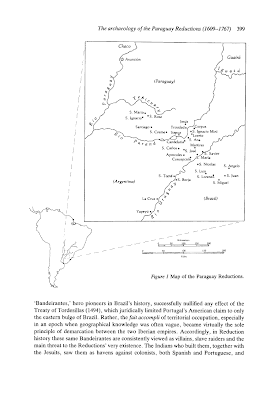
From Chapter XIV, pages 341 and 342, of John Campbell’s Spanish Settlements in America:
"Thefe Indians are divided into forty-two parifhes, all on the banks of the river Paraguay and Parana, and none above thirty miles diftance from another. In each parifh there is a Jefuit, who is fupreme in all caufes, as well civil as ecclefiaftical, from whofe decifion there lies no appeal. By him their caciques or chief officers are nominated, as alfo all inferior ones; and even their military commanders receive their orders from him. Nothing can be better contrived than the regulations under which they live. Every family hath its proportion of land and labour. Induftry is common to all, yet wealth is attained by none; the product of their harveft is carried into the fociety’s magazines, whence the fathers difpenfe whatever to them appears neceffary to every family according to its degree. The furplus, which is very confiderable, faid to amount about 800,000 pounds Sterling, is fent to Cordova or Santa Fee, there being at each place a procurator-general, who takes care of what belongs to the fociety, and as occafion offers, tranfports their wealth into Europe."
This brief excerpt from John Campbell’s Spanish Settlements in America, illustrates the rigid structure in the Jesuit Reductions between the Guaraní Indians and the Jesuit priests. For example, “the Jesuit is supreme in all causes, as well as civil as ecclesiastical”… “from whose decision there lies no appeal.” (341) “Wealth is attained by none”… “the fathers dispense whatever to them appears necessary to every family according to its degree.” (342) The Jesuits were clearly in charge of everything that took place in the Reductions, they were the government, they were the church, they proportioned out the land and labor, and they dispensed the food to each family according to their specific needs. The sistema de castas in the Jesuit Reduction is much more socialistic because there is only a distinction between the Jesuit priests and the Guaraní Indians; there is no wealthy, middle class, or poor sections of society. The Jesuit priests did not allow any of the Indians to achieve any wealth or any particular Indian to gain power, the Jesuits appointed each cacique and military officer themselves rather than let them come to power through a hereditary system.
The result of the Jesuit Reductions in Paraguay is that we get to see a system much different here than has been seen in other Spanish colonies. The Jesuits were undoubtedly in charge of everything that took place in the society and took measures to prevent the emergence of a class system that was evident in other colonial societies in the Spanish empire.
Campbell, John. An account of the Spanish settlements in America. In four parts. ... To which is annexed, a succinct account of the climate, produce, trade,manufactures, &c. of Old Spain. Illustrated with a map of America. Edinburgh, 1762. Eighteenth Century Collections Online. Gale Group.http://galenet.galegroup.com.ezproxy.fau.edu/servlet/ECCO.











